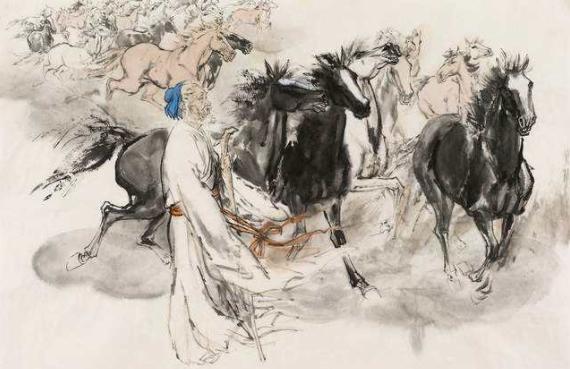Throughout Chinese history, the earliest horses were introduced to the Central Plains for military purposes. They were mainly used to equip cavalry against invasions from the nomadic peoples of the northwest, so they became one of the most valuable tributes of the time, and the possession of horses became the prerogative of the imperial relatives and scholars. Thus in early Chinese paintings, horses usually appear in war or hunting scenes. The two most important themes of early horse painting were "Mu wang bajun" and "Bole three horses", and from this two most typical horse painting series developed: the royal horse statue and the centaur figure.

The earliest Chinese Imperial Horse Diagram may be the Eight Juntu of Mu Wang. It records that during the travels of King Mu of Zhou, the fifth king of the Zhou Dynasty, during his travels to the West, Jiuyi, who had originally submitted to King Mu, began to have a warm relationship with the state of Xu, the emptiness of the Central Plains, the crisis of Zongzhou, and the king of Mu heard the news, immediately jumped into the carriage pulled by the eight good horses, traveled day and night, returned to Zongzhou, and went on a crusade to the east, breaking Xuyi. To commemorate his triumph and consolidation of power, he instructed his men to draw his eight warhorses. Since then, this theme has become a typical illustration of Chinese horse painting.
According to the Song Dynasty Guo Ruoxuan's "Pictorial Insights and Records", the authentic manuscript of the "Eight Juntu of Mu Wang" was still circulated in the third century AD during the reign of Emperor Wu of Jin (265-290 AD). Later, Emperor Wu of Jin ordered Shi Daoshuo to depict it as it was. This facsimile of Shi Daoshuo was circulated in the southern court, and the Song, Qi, Liang, and Chen all regarded it as a national treasure until Chen was destroyed by the Sui Dynasty. The painting fell into the hands of He Ruobi, and Yang Huan, the King of Qi, exchanged it for forty horses and fifty pieces of beautiful brocade, and dedicated it to the Sui Emperor. During the reign of Tang Zhenguan, Tang Taizong lent this legendary painting to Li Tai, the King of Wei, and as a result, the painting was copied and copied and passed on to the world.
The legendary image of the "Eight Horses of King Mu" and the glorious image of the ruler expressed by it made many later emperors imitate it, to praise and record their war horses. Among them, Tang Taizong remembered his military achievements in the form of six war horse portraits, and the portraits of these six horses were later copied to the stone slab and placed in Emperor Taizong's mausoleum Zhaoling, known as the "Zhaoling Liujun".
Another theme of early Chinese horse painting is "Bole Three Horses", which depicts the story of Bole's discovery of three thousand-mile horses in the seventh century BC, from which the aesthetic and symbolic significance of early Chinese horse painting can be better understood. In the era of Bó Lè, the basic aesthetic standards for horses were closely related to Chinese physiognomy, and bones and muscles were the main basis. This criterion explains why early horse artists always paid attention to outlining the bones of horses.
The horses in the Ancient Scrolls mostly appear in bizarre shapes, sometimes more like dragons. Zhang Yanyuan, a Tang dynasty art historian who was the first to discover this problem, wrote: "The ancients painted horses with the "Eight Juntu", or the traces of Yunshi Daoshuo, or the traces of Yunshi Bing, all of which were the body of the dragon with a neck, and the arrows were excited, and the shape of non-horses was also. This unrealistic depiction was typical in ancient China, where animals were still associated with ancient myths and legends.
The source of this article is the Chinese Equestrian Association, please indicate the source when reprinting
If there is any infringement, please contact to delete it
Editor-in-charge | Hu Xiaomast
Edit | Small card